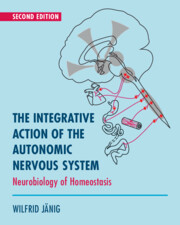Book contents
- The Integrative Action of the Autonomic Nervous System
- Reviews
- The Integrative Action of the Autonomic Nervous System
- Copyright page
- Dedication
- Contents
- Foreword to the Second Edition
- Foreword to the First Edition
- Preface
- Abbreviations
- Introduction The Autonomic Nervous System and the Regulation of Body Functions
- Part I The Autonomic Nervous System: Functional Anatomy and Interoceptive Afferents
- Part II Functional Organization of the Peripheral Autonomic Nervous System
- Part III Transmission of Signals in the Peripheral Autonomic Nervous System
- Chapter 6 Impulse Transmission Through Autonomic Ganglia
- Chapter 7 Mechanisms of Neuroeffector Transmission
- Part IV Representation of the Autonomic Nervous System in the Spinal Cord and Lower Brain Stem
- Part V The Centers of Homeostasis in the Mesencephalon and Hypothalamus and Their Telencephalic Control
- Index
- References
Chapter 6 - Impulse Transmission Through Autonomic Ganglia
from Part III - Transmission of Signals in the Peripheral Autonomic Nervous System
Published online by Cambridge University Press: 16 July 2022
- The Integrative Action of the Autonomic Nervous System
- Reviews
- The Integrative Action of the Autonomic Nervous System
- Copyright page
- Dedication
- Contents
- Foreword to the Second Edition
- Foreword to the First Edition
- Preface
- Abbreviations
- Introduction The Autonomic Nervous System and the Regulation of Body Functions
- Part I The Autonomic Nervous System: Functional Anatomy and Interoceptive Afferents
- Part II Functional Organization of the Peripheral Autonomic Nervous System
- Part III Transmission of Signals in the Peripheral Autonomic Nervous System
- Chapter 6 Impulse Transmission Through Autonomic Ganglia
- Chapter 7 Mechanisms of Neuroeffector Transmission
- Part IV Representation of the Autonomic Nervous System in the Spinal Cord and Lower Brain Stem
- Part V The Centers of Homeostasis in the Mesencephalon and Hypothalamus and Their Telencephalic Control
- Index
- References
Summary
Synaptic transmission from preganglionic to postganglionic neurons in autonomic ganglia is cholinergic nicotinic. Most autonomic ganglia transmit the central message with high accuracy to the postganglionic neurons. This concurs with the idea that the target tissues are predominantly under the control of the central nervous system. A small number of sympathetic preganglionic neurons connect to a large number of postganglionic neurons. This divergence is primarily for distribution. Additionally, postganglionic neurons receive convergent synaptic input from several preganglionic neurons. Neurons in sympathetic paravertebral and parasympathetic ganglia and some neurons in prevertebral ganglia receive one or two suprathreshold preganglionic synaptic inputs, the rest being subthreshold. Discharges in these postganglionic neurons are generated by strong synaptic inputs but not by summation of weak synaptic inputs. Some neurons with non-vascular functions in sympathetic prevertebral ganglia receive, in addition to preganglionic inputs, cholinergic synaptic inputs from peripheral intestinofugal neurons. In many sympathetic neurons of the prevertebral ganglia, and in some parasympathetic ganglia, the central synaptic input is weak or even may play a subordinate role. Nicotinic synaptic transmission in vasoconstrictor neurons in sympathetic ganglia can be enhanced by muscarinic and non-cholinergic mechanisms.
Keywords
- Type
- Chapter
- Information
- The Integrative Action of the Autonomic Nervous SystemNeurobiology of Homeostasis, pp. 167 - 199Publisher: Cambridge University PressPrint publication year: 2022



